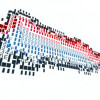Is D-Wave’s quantum processor really 10⁸ times faster than a normal computer?
We have been following D-Wave's claims about its quantum hardware at Ars for a number of years. Over that time, my impression has oscillated between skepticism, strong skepticism, and mild enthusiasm.
Back in November, D-Wave issued a press release that basically asked tech journalists to spray paint a finish line just behind their feet and break out a victory flag. It seemed a bit much. But now that D-Wave has declared victory, perhaps it's time to re-examine the skepticism. What exactly has D-Wave achieved, and does it constitute victory? Either way, where are the company's efforts focused now?
Of course the best way to judge D-Wave is not by its press releases nor by the specifications and benchmarks glued on the boxes of its processors—these should be treated with utmost paranoid suspicion. Instead, it's better to look at what researchers who have access to D-Wave hardware are claiming in publications. And despite my suspicions, the paper accompanying that last press release—plus a couple of other papers on the arXiV that were released earlier—is interesting. All together, they paint a picture that says we should finally be cautiously optimistic about D-Wave's progress.









































































